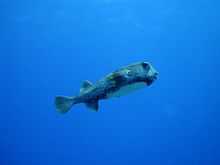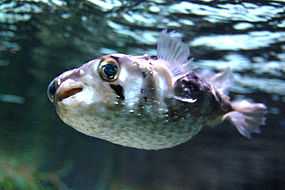Diodon
From Wikipedia, the free encyclopedia
| Porcupinefishes Temporal range: 55–0Ma Early Eocene to Present[1] | |
|---|---|
 | |
| Diodon holocanthus | |
| Scientific classification | |
| Kingdom: | Animalia |
| Phylum: | Chordata |
| Class: | Actinopterygii |
| Order: | Tetraodontiformes |
| Family: | Diodontidae |
| Genus: | Diodon Linnaeus, 1758 |
| Species | |
|
See text | |
Members of the Diodontidae, species of the genus Diodon are usually known as porcupinefishes or balloonfishes.
Distinguishing features
Fish of the genus Diodon have;
- two-rooted, moveable spines (actually modified scales) distributed over their bodies.
- beak-like jaws, used to crush their hard-shelled prey (crustaceans and molluscs).[2]
They differ from the swelltoads and burrfishes (genus Cyclichthys and Chilomycterus), which have fixed, rigid spines.
Defense mechanisms
- Like pufferfishes they can inflate themselves, making their spines stand perpendicular to the skin. When inflated they pose a major difficulty to their predators: a large diodon fully inflated can choke a shark to death. According to Charles Darwin in The Voyage Of the Beagle (1845), Darwin was told by a Doctor Allen of Forres, UK that the Diodon actually had been found "floating alive and distended, in the stomach of the shark" and had been known to chew its way out of shark bodies after being swallowed, causing the death of its attacker. [3]
- They may be poisonous, through the accumulation of tetrodotoxin or ciguatera.[2]
Species
There are currently five recognized species in this genus:[4]
- Diodon eydouxii Brisout de Barneville, 1846 (Pelagic porcupinefish)
- Diodon holocanthus Linnaeus, 1758 (Long-spined porcupinefish)
- Diodon hystrix Linnaeus, 1758 (Spot-fin porcupinefish)
- Diodon liturosus G. Shaw, 1804 (Black-blotched porcupinefish)
- Diodon nicthemerus G. Cuvier, 1818 (Slender-spined porcupinefish)
-

Diodon holocanthus
-

Diodon hystrix
-

Diodon liturosus
-

Diodon nicthemerus
-

Diodon holocanthus puffed up and taken out of the water.
References
- ↑ Sepkoski, Jack (2002). "A compendium of fossil marine animal genera". Bulletins of American Paleontology 364: p.560. Retrieved 2007-12-25.
- ↑ 2.0 2.1 Lieske, E. and Myers, R.F. (2004) Coral reef guide; Red Sea London, HarperCollins ISBN 0-00-715986-2
- ↑ Darwin, Charles (1845). Journal of researches into the natural history and geology of the countries visited during the voyage of H.M.S. Beagle round the world, under the Command of Capt. Fitz Roy, R.N. 2d edition. London: John Murray. p. 14.
- ↑ Froese, Rainer, and Daniel Pauly, eds. (2012). Species of Diodon in FishBase. October 2012 version.
This article is issued from Wikipedia. The text is available under the Creative Commons Attribution/Share Alike; additional terms may apply for the media files.